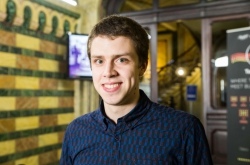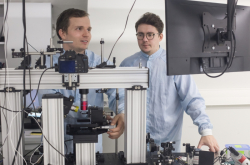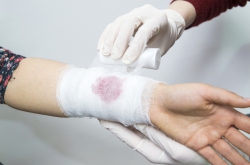These days, cardiovascular diseases are one of the main causes of mortality in developed countries. According to the statistics by the Federal State Statistics Service, in 2015, 26% of people died of ischemia, over 15% – of different malignant tumors.
Modern medicine focuses on development of new effective medications, but some of them cause serious aftereffects – being toxic they may remain in tissues. To minimize a negative affect one can use targeted drug delivery.
“There are two ways of drug delivery: passive and active. An affected tissue is more porous than the healthy one, that is why a drug can stay in the first one for a long time. For example, light-sensitive matters for photodynamic therapy (photosensitizers) are oncotropic – it means that they can be localized selectively in tumors. As of now, active targeting is more and more popular. Our lab plans to work on this field,” says Yana Toropova, head of the laboratory for Bioprosthetic Repair and Cardioprotection at the Federal Almazov North-West Medical Research Centre.
The specialists of the new center plan to provide targeted drug delivery using hybrid magnetically controlled nanosystems. Their complicated structure includes magnetic core, a polymeric layer with quantum dots and a biodegradable layer, which contains molecules of a medication.
Magnetic properties of nanoparticles depend on their size, but it is very hard to choose the proper one – if the particles are too small, it will be difficult to control them by a magnetic field. Using particles that are more than one requires (the proper amount is determined by the type of material – the researchers use Fe3O4, which requires 4-5 nanometers) leads to aggregation of particles. To solve this problem, one needs to use small particles – their amount has to be enough for external control. It means that the core of the system has to include several superparamagnetic nanoparticles of the ferrous oxide.
The magnetic core is covered with a polymeric layer and then with quantum dots that serve as luminescent biomarkers to detect how nanosystems move inside an organism. The researchers are going to use quantum dots consisting of an indium phosphide – in comparison with dots made of cadmium ions their biodegradation is less toxic. The quantum dots are covered with one more polymeric layer which can be enriched with various medications.

“This system can be used for different purposes. But we will start with drug delivery to a stunned myocardium as well as the therapy of malignant tumors in genital organs,” says Anna Orlova.
The researchers will treat oncological diseases using a pioneering method. They will put a stent with magnetic elements inside the affected organ – the stent will attract nanosystems. Usually when it is possible to apply laser radiation, one can use photodynamic therapy. In comparison with chemotherapy and photon therapy it has fewer aftereffects, but anyway they still exist. The oncotropic coefficient of modern photosensitizers is up to 10, i.e. diseased tissues receive 10 times more medications than healthy ones. When the concentration of photosensitizers in the tumor is enough to remove it, the organism has already been affected by toxic elements. Those who have undergone photodynamic therapy, have to avoid sunlight for six months after the procedure. Targeted drug delivery of photosensitizers doesn’t cause such aftereffects.
In cases when it is impossible to apply optical fiber to the tumor one uses local chemotherapy. Using magnetically controlled nanosystems one can deliver cytostatic to diseased tissues so as to stop uncontrolled cell division.
Apart from targeted drug delivery for oncological disease therapy, the researchers of the center plan to develop nanosystems for delivery of cytoprotective drugs aiming at treatment of ischemic heart diseases. Unlike photosensitizers, cytoprotectors cannot be localized selectively in a stunned myocardium. There are several medications for blood flow recovery in a diseased tissue, but they are not used due to a high toxic property. Thanks to the targeted delivery method it will be possible to develop new cytoprotectors and increase patient’s quality of life.
“Our team is unique as we managed to gather high quality specialists that are versed in all processes related to creation and analyzes of the nanosystem – from synthesis of separate components to animal testing. We have been working on quantum dots and the hybrid system based on them for ten years. Also for the last two years we are studying how magnetic nanoparticles interact with quantum dots and molecules. We understand that development of an effective and safe nanosystem requires not only cell culture assay, but also in-vitro testing. That is why we bring together our knowledge with the experience of researchers from the Institute of Experimental Medicine at the Federal Almazov North-West Medical Research Centre”
Another research team, which works on the project is staying in Trinity College, Dublin. Yury Volkov is one of the top specialists in the field of nanotoxicity. Due to its size nanoobjects can penetrate into cells in special ways and get stuck into intercellular matrix. It is very hard to excrete such substances out of the organism. That is why when one makes a model of a nanosystem one has to take into account their toxicity.
The researchers plan to test the safety of hybrid nanosystems and efficiency of magnetically controlled targeted delivery using cell cultures, small animals (fishes and mice) and then miniature pigs for the last stage of the research. The approximate deadline for this work is the end of 2018.
The International Research Center of Magnetically Controlled Nanosystems for Theranostics of Oncological and Heart Diseases is a part of ITMO’s International Research and Education Center for Physics of Nanostructures. Apart from scientific projects the researchers pay attention to education - it is planned to organize seminars headed by Russian and international specialists dealing with applications of nanostructured materials to biology and medicine. The center also initiates summer schools for high school students - this year the educational program will be enhanced by involving biologists and medical experts into the activities of the schools.
Written by Ksenia Zhirnova, Master’s student of the Science Communication Program.



